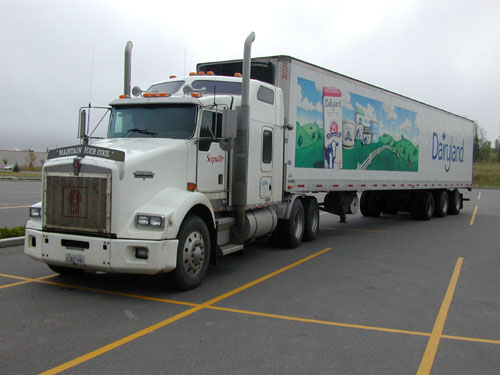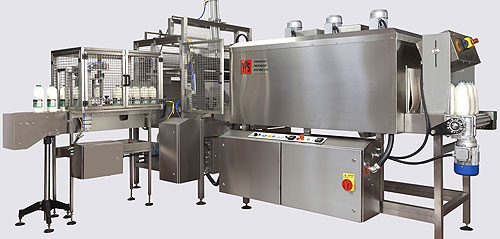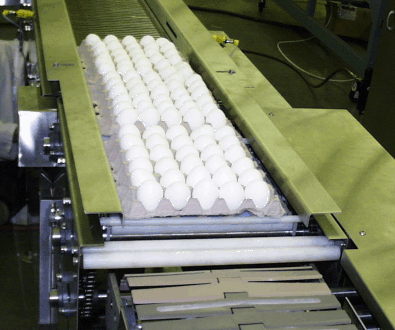To start my day on the right foot, I like to eat four large Western Family eggs, along with a large glass of milk. I have this meal every single morning and is essential for me to have energy to start my day and help get me through the school day.
Dairlyland Milk
Production
Dairy farming is a very prominent industry throughout Canada. These farms raise their cows until they are of age to start producing milk, then are milked on the dairy farm, through the use of machinery. The milk gets sucked through a vacuum and placed into large containers. The cow usually takes around five minutes to complete the milking process.The extracted milk passes through a strainer and heat exchangers before entering the large container where it will spend the next few days sitting at a temperature of approximately 42 degrees f/h. Milk trucks will then pump the milk where it gets transported to dairy factories, processed and packaged into consumer products. The processes of production require a lot of energy as machinery is a prominent system used in getting the milk from the cow itself, to the fridge of the consumers. Also, the cooling system that is required for the milk to sit in for days at a time uses a lot of energy as it is a man made environment where energy creates a cooled environment for milk to stay fresh. Also, heavy machinery is needed to provide food to the cows as farmers get feed supplies from either their own production or purchased from grain farms locally and abroad. Like most products I’ve talked about, milk that is produced on small operations requires less technological influence where manual labour can dominate but, when it comes to large operations such as Dairlyland, machines are needed to ensure mass production.
Transportation
Transportation is needed in two separate ways. First is getting the raw milk from production farms to factories that process the milk for consumers. Then, the milk is transported again to retailers and consumers. Milk is fortunately a prominent industry in Canada which means that it can usually be produced locally in many regions, minimizing distance between production and consumption. The main source of transportation is done via the trucking industry, which is a big contributor to harmful emissions and energy outputs. Canada doesn’t need to export most of it’s milk so the industry stays concentrated within Canada and many different provinces can produce milk to their local communities.
Packaging
Milk packaging requires a heavy use of machines and processes which begins with creating the container itself. Some containers are made from a paperboard product that starts it’s energy consumption at a paper mill.The transformation of hardwood and softwood into pulp requires a great deal of energy and fuel. It is then formed into paperboard which is then lined with polyethylene which is a type of water proof plastic. Once the carton is created, it must be stamped and labeled to showcase the companies logo and nutrition facts. All of these steps require a lot of energy with automated machinery that uses large volumes of energy to create the packaging package for the milk so it can then be sold to consumers.
Western Family eggs
Production
Eggs are again one of the essential food staples in North American and are produced at very large volumes to cater to the enormous demand. They are produced through chicken farms where hens lay eggs which are then mechanically shuttled onto a conveyer belt where they will be processed and sorted to get ready for packaging and transportation. The employees will monitor the eggs for cracks so they are not packaged and sold. They also need to go through a heating faze where they are warmed to a certain temperature, then sit for a short period of time after they have been cleaned. The chickens also need to be constantly fed to make sure they are able to stay alive and produce a good amount of eggs. The production process is not as energy dependent as the milk production process is. However, it is still important to note that oil and energy is being used in almost all facets of the production system and make up the majority of the automated production process with as little human labour as possible.
Transportation
Eggs are usually grown locally so the need for intensive transportation is minimized. The eggs I eat from Western Family come from Oregon which is a short distance to retailers in Vancouver. They are usually brought via trucking systems and need to be cooled from the inside. The method of cooling along with the transportation itself require large levels of energy. Not only do the eggs need to be transported from producer to consumer but, the chickens themselves are brought to the farms via trucks, where they will lay the eggs. Fortunately egg production is across North America limiting the need for massive transportation plans and reducing the energy needed compared to other perishable products.
Packaging
The packaging required for eggs is actually quite sustainable because the cardboard is made from recycled materials and not from new raw materials. The material used for the packaging only needs to be produced into a very rough material. It is used only for egg cartons and does not require further production into finer paper products from recycled material. They also will need to be stamped and imprinted with company logos which of course calls for the machinery and technology to do so. The use of automated production to speed up the packaging process creates a greater need for energy contributing to the release of harmful fossil fuel emissions.








